It can be really stressful being an antique jewelry collector. Not only do you have to be sure the antique jewelries are authentic, but it’s also quite arduous to determine the piece’s age, style, and material used in making it.
The stamp on collectible jewelry, also called jewelry stamps, are what will come to your aid; they are as fascinating as the actual items.
These little impressions on the item stand to show the validity of the jewelry and occasionally reveal the date of manufacture.
The marks typically consist of the name or initials of the producer or designer. You’ll need to be familiar with these markings and the makers in order to determine and estimate the value of your pieces. As a result, these antique symbols stamped on the jewelry will serve as the waypoints in your exploration.
But first, there is so much you need to know about these symbols stamped on your old jewelry. So keep reading to discover more.
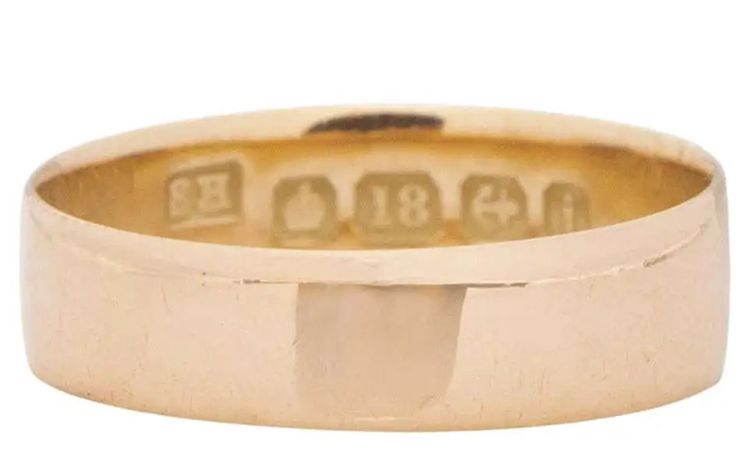
Table of Contents
The Jewelry Stamped Symbols
Identifying original pieces has been a problem with jewelry for a long time. So it is conceivable that some person unperturbed by any harsh penalties might find a way to tamper with precious and valuable pieces.
Also, people might amass a small fortune over time by scraping a little bit of a gold coin or tampering with a golden decoration while passing it off as though it were pure gold.
For this reason, various European sovereigns created special legislation to safeguard customers in the late middle ages mandating that all gold and silver objects bear a distinctive stamp or symbol that identifies the producer of the jewelry or item.
The use of these symbols and jewelry stamps as a way to ensure consumer protection went on until the middle of the 19th century.
Then things began to take a different turn when counterfeit stamps and symbols, often known as “pseudo marks,” started to be sold to evade taxes. The English government then increased taxes on imported gold and silver jewelry or general artwork.
As it’s typical with most businesses, they have never prioritized paying taxes. So, some gold and silversmiths in parts of Europe started stamping markings that resembled antique jewelry stamps and symbols on their jewelry and silverwork.
Timeline of Jewelry Stamps
The National Gold and Silver Stamping Act of 1906 mandated that jewelers provide an exact purity or fineness mark with the metals used on a piece when selling it in the United States.
Jewelry producers were additionally required to incorporate a producer’s mark in 1961, identifying the person or business that made a particular piece of jewelry. The purpose of this 1906 law was to safeguard and educate the public about the use of jewelry markings.
The stamp carried details of the amount and type of materials that went into making a specific piece.
A maker’s mark, which served as a means of allowing only original works of art, identified the manufacturer of a piece of jewelry and was also mandatory by the American government in the mid-20th century.
In Britain, hallmarking has a long history that dates back to the 14th century. The Hallmarking Act of 1973 governs current requirements.
Before the fall of the 20th century, all items of British jewelry had to receive a stamp with a date symbol.
The symbols were letters that corresponded to the year of registration of the jewelry with the assay office.
Assay offices are governmental institutions entrusted with testing the purity of metals used in jewelry, and, in some situations, they also hallmark and assay the jewelry.
French jewelry markings are considerably older, with the earliest recorded instances appearing in the medieval period. Therefore, if you collect French antique jewelry, the year 1797 is crucial to remember.
Common Types of Jewelry Markings
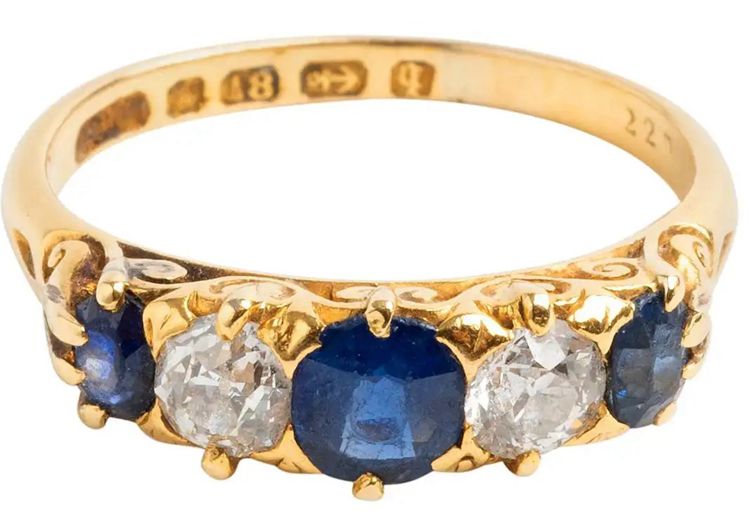
The ability to interpret trademarks and stamps depends so much on certain factors. While a novice is more likely to make mistakes, a pro in the game is sure to know what almost every symbol connotes.
The symbols discovered must always be consistent with other indicators, such as style and production method.
Four primary hallmark kinds might reveal essential details about the place of origin of jewelry goods and their authenticity.
Depending on their place of origin, some of these symbols and stamps may come together into a single mark, or they may not exist for various reasons.
But without further ado, let us look at the four main types of marks you may find on antique jewelry.
Date Letter or Marks
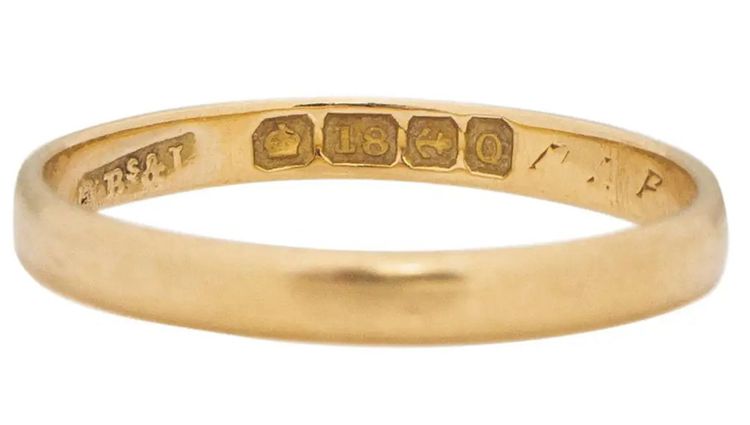
Although you may not see date symbols on very complex jewelry, they still date back to the fall of the 15th century and early 16th century in the United Kingdom.
All gold and silver artifacts are malleable, so they can get mixed with alloys to make them stronger. For this reason, they were meant to undergo official assays at Goldsmith’s Hall in London at the time due to new English rules.
It had to carry the inscriptions of the “Hall,” which serves as the cradle of the name “hallmark.” Aside from that, it required the most notable member to serve as the head assayer, but the position rotated annually.
When issues of assayer fraud began to spring up, they came up with a new assay symbol. The new symbol took the form of an alphabetic letter.
Although the letters’ original use was to identify the accountable assay master, they are now used as a “date letter” to specify the date the item was assayed.
Every cycle employed a distinct letter font and symbol contour to avoid confusion.
In actual practice, the identity of the assay officer who wrote it rarely bothers the curiosity of jewelry historians.
The date symbol does not denote the year of fabrication, contrary to common belief, but rather the year the item was assayed. So, in other words, the data symbols are just a means of knowing when the jewelry was assayed.
In the U.K., using a date symbol has become optional in recent years. Since delicate jewelry frequently lacks space for a complete set of marks, one hardly ever finds a date letter on such objects.
Purity Marks
The purity mark is one of the first stamps to chesck for while examining jewelry. When such a mark is discovered, it indicates the amount of precious metal used to make the object.
In the past, those who could buy golden body adornment did not care about doing housework.
As a result, their jewelry was not easily damaged by wear and tear. But later, they added different metals to the precious metal to strengthen it and increase the durability of the gems by adding a blend of several metals called an alloy.
For this reason, it became mandatory and wise to add information on the number of precious metals that went into creating a piece of jewelry. By so doing, consumers will not buy fake for the original price.
The purity mark still serves its purpose for antique collectors since it is an excellent way to ensure a piece of authentic antique jewelry.
Let us look at two significant precious metal purity marks below.
Gold Purity Jewelry Stamped Symbols
Since pure gold is so delicate, it is not a good material for making jewelry. Until the middle of the 20th century, karats were the primary way to convey this purity, indicating its potential origin.
The unit of measurement for the weight of gold is karats, with 24 representing the purest form of gold.
If the jewelry has an 18k purity stamp, it means that there is 75% of gold in that piece of jewelry and the remaining 25% are other parts of the alloy used to make it.
While the USA and some other nations use stamps like 14k and 18k to indicate the purity of the precious gold jewelry, many other nations use pictorial marks.
To distinguish between the various stamps used worldwide, one needs a good knowledge of them all.
As a result, you can have antique gold jewelry engraved with HGE, G.E., or G.F., which means heavy gold electroplate, gold electroplate, or gold filled, but still not an original piece.
Silver Purity Jewelry Stamped Symbols
The purity stamps for silver and platinum are very similar to those for gold, but the pictorials and numerals are different.
Some silver jewelry has the numbers 800 or 900 stamped on it. The reason is that the metal content does not contain up to 92.5 percent pure silver (also written as .925).
Consequently,
Eighty percent pure silver is present in silver jewelry with the “800” mark, and items with the inscription “900” have a 90% silver content, falling short of the sterling silver requirement of 92.5% purity.
On numerous USA jewelry produced after 1870, you may come across inscriptions like “sterling,” “925,” or “STG.” But that mark won’t be present on English pieces unless they were made specifically for export.
Another mark on antique jewelry patterning purity is “Vermeil.” Vermeil is simply a sterling silver or other alloys like zinc and copper that is gold plated.
Instead of using the vermeil technique, some designers enhanced the silver product with a thinly applied gold wash. In the 1940s, the gold wash was the order of the day.
Gold wash costume jewelry, introduced due to the wartime metal shortage, was well-liked, strong, and attractive. Sterling silver was a good choice as the base metal for jewelry items, and the gold wash fulfilled desire.
Maker’s Mark
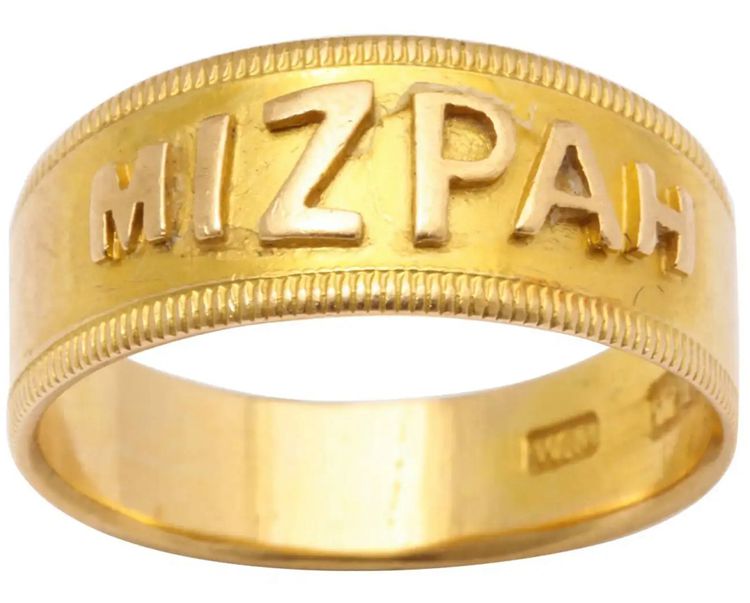
You may need to use logos, trademarks, corporate names, and artist signatures to identify the jewelry maker.
The maker’s mark has historically been the primary indicator of an artifact’s gold content. The maker’s mark identifies the individual in charge of ensuring the object’s purity; it does not necessarily imply that the item was manufactured by the person whose mark is struck.
It also acts as a trademark in current times, and notable names are a value-added commission.
One can quickly locate the manufacturers and hold them accountable when issues develop.
These stamps and symbols had to be distinct in many nations with a long history of required hallmarking, and they stored copies of these marks carefully in the trade records.
These stamps often have the maker’s initials and a pictorial mark in a particular contour. Some restrictions required the contour to have a precise shape.
The Cartier hallmarks have changed over time per legal restrictions, although more contemporary pieces always include the complete Cartier name and a unique serial number. You take any antique piece without those clues with a grain of salt.
In the USA, these symbols can take the form of a registered trademark or the complete name of the manufacturer or company.
The Cartier hallmark
Towns Mark
When we get to maker’s marks, things start to get tricky.
In their lengthy history, renowned jewelry manufacturers like Tiffany have gone by various names, including “Tiffany & Co.” and “T and Co.”
Some well-known Tiffany designers, like Paloma Picasso, are deserving of their unique insignia.
Many countries with an obligatory hallmarking system created new assay offices scattered across the nation in the late Middle Ages and the renaissance to accommodate precious local metalsmiths.
A new mark, the town mark, was developed to help distinguish between the markings used in those towns. This symbol typically appeared as the city’s heraldic shield or another recognizable graphical symbol.
The assay mark for Birmingham, England, is an anchor, which is illogical given that Birmingham lacks a port and is not situated close to a body of water.
Many things have been struck with the Birmingham town mark, which has made its assay office the biggest in the world today.
Some structures, like the Dutch hallmarking system, used the town mark in conjunction with some other mark to reveal the purity of the precious metal used to create a jewel or larger object.
In France, it was traditional to have two purity marks: one for products created in Paris and another for those made in the provinces, the latter of which could occasionally identify as a number.
Other Jewelry Symbols
Numerous more stamps on jewelry products are not hallmarks but are crucial for evaluating jewelry. Here are some of them in more detail.
Patents
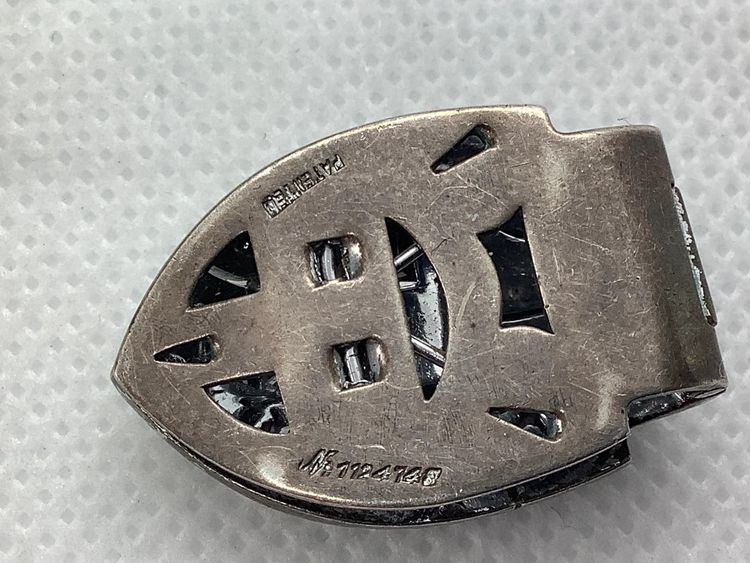
Aside from typical markings like date marks, purity, and assay marks, patent marks or numbers are other symbols stamped on antique jewelry.
When there were no copyrights to protect jewelry designs, jewelry patents were quite prevalent. A design patent only covers how a produced object appears; it does not cover how it functions or is built. Therefore, by requesting patent protection, businesses could safeguard their intellectual property rights over a unique design.
Businesses and jewelry makers usually complete this step before entering the market to prevent a rival from stealing their design and making money.
You may find the patent number in discreet places on your jewelry. The reason is so as not to detract from the item’s design.
Some antique jewelry may even have a patent number stamped on them, especially those with distinctive structural features like Italian charm bracelets.
This patent represents the number assigned to the corporation when it registered its design with the U.S. government.
You can do a quick online search with the patent number at specific concerning websites to help you learn more about the business. An example of such a website is the United States patent and trademark office.
You’ll learn who owns the patent or what business submitted it. You will also have a good knowledge of the filing details, and occasionally you’ll get drawings or design data.
Monograms and Engravings
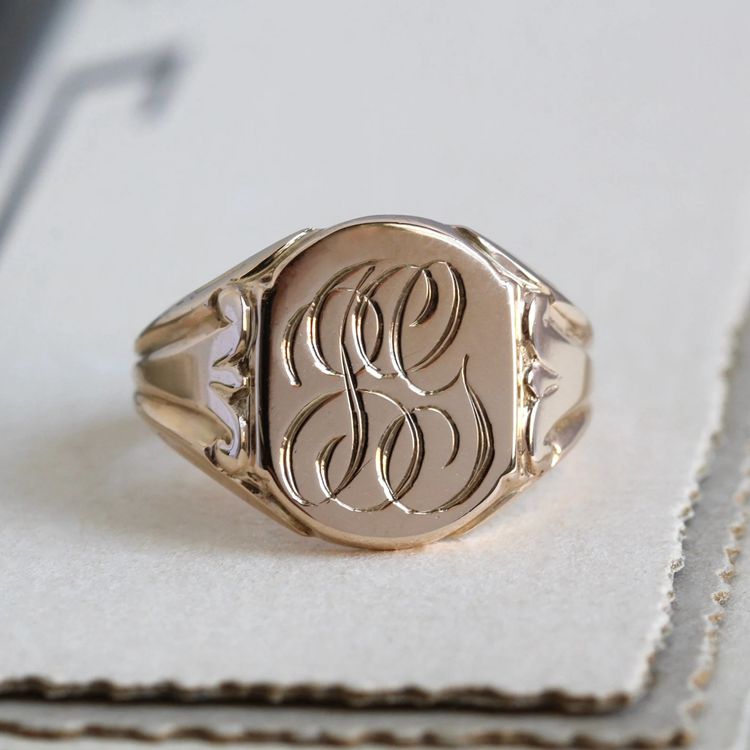
Monograms can be placed anywhere on the item and typically have two or three initials. These private remarks may reveal the prior owners of vintage or antique jewelry.
Usually, engravings are found on the jewelry’s bottom or back and take the shape of a message, name, or date.
While many jewelry marks are present when the item is made, this isn’t always the case. The jewelry buyer may occasionally ask for the item to be engraved or personalized.
For example, look at this exquisite vintage signet ring made of 10k yellow gold from the 1920s. The cartouche is inscribed with the whimsical ribbon script “J.G.” and is surrounded by deeply chased shoulders in an ionic column motif that perfectly captures the era’s vibrant graphic style.
Other symbols include:
- Import/Export
- Designer Marks
- Tally Marks
- Retailer Stamp
- Duty Marks
How to Decipher Antique Jewelry Stamped Symbols
Whether you choose stylish fine jewelry or entertaining costume jewelry, you’ll see that almost every piece in your jewelry collection includes markings.
Understanding what these markers imply is helpful since they provide essential details about your piece.
Your jewelry markings can provide information about your favorite items’ metal content and maker.
You can ensure you receive the quality for which you are paying by knowing how much metal is in your piece.
Numerous markings on jewelry indicate the metal content of the item. This is significant because sterling silver- and silver-plating objects appear nearly identical to the untrained eye.
You need to look at the jewelry closely to find the metal composition. It may be on the inside rings or the back of pendants, pins, and brooches. But with a trained eye, you’ll typically find inscriptions indicating what went into making the piece.
The standard is a little less clear when it comes to the legal compliance authority for the jewelry industry.
Contrary to popular belief, jewelry producers are not usually compelled to stamp the metal composition of their products.
Although precious metal content is not required to be stamped on jewelry in the United States, producers must disclose it to the consumer.
It may appear on the appraisal included with the item. You may also find it on a hang tag or other jewelry parts, the purchase invoice, or any of these.
By doing this, the manufacturer or seller of the jewelry may legally guarantee that the metal content they are identifying will get the respect it deserves.
However, stamping is not legally required for non-precious metals like tungsten, stainless steel, and titanium.
Suppose the producer does stamp the item with the materials that went into making the piece. In that case, they must also place their trademark or the merchant’s trademark immediately adjacent to the metal content designation.
There are more problems for collectors due to different variations of marks and symbols on antique jewelry. The reason is due to the many means of ensuring consumer protection adopted by different nations.
The good news is that it’s easy to find a lot of websites that can point you in the right direction. But unfortunately, you may not find all the jewelry symbols needed on this site.
Antique Jewelry Without Stamped Symbols
As mentioned earlier, some jewelers did not stamp their items with any marks. Although the maker or seller of the jewelry must alert customers to the presence of precious metals, this does not always require stamping the item.
It may be stated on a hang tag, the appraisal included with the jewelry, the receipt, or even the purchase invoice.
So jewelry was sold without symbols over a long period during the Victorian and Georgian eras.
For this reason, it’s normal to have antique jewelry without any metal content stamped on it. For a fact, symbols became compulsory in jewelry recently from the early 19th century.
So the Assay Office is exempt from the standard assaying of an item made before 1950. But a professional appraiser can still point out authentic pieces from the past.
Bottom Line
The purpose of jewelry stamps was to protect consumers from fraud. However, even to date, collectors still refer to it when dating and authenticating antique jewelry pieces.
To decipher antique jewelry symbols today, and pick the valuable from the worthless, requires study and practice.
Hopefully, this article has provided the needed information to guide you through this practice process. So keep practicing, for you never know what treasure you may discover.
However, professional appraisers spend years mastering the history and art of trademarks, but the fun is in the exploration itself.
They can be your last resort when dating or identifying the worth or manufacturer of your old jewelry.

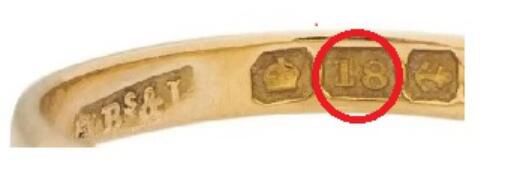
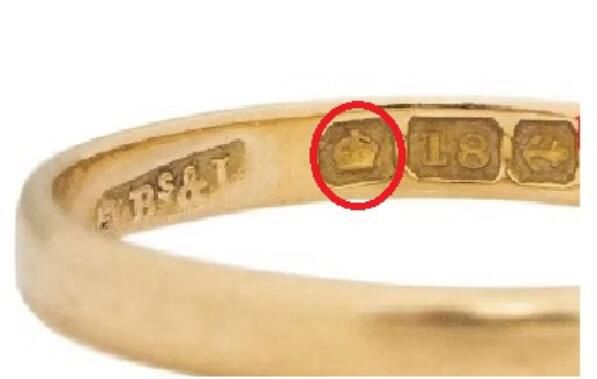




![Where To Sell Antique Furniture In 2022 [Ultimate Guide]](https://www.jacquelinestallone.com/wp-content/uploads/2022/09/Etsy-Your-Place-To-Buy-And-Sell-All-Things-Handmade-600x450.jpg)


